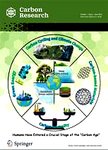版权所有:内蒙古大学图书馆 技术提供:维普资讯• 智图
内蒙古自治区呼和浩特市赛罕区大学西街235号 邮编: 010021

作者机构:Key Laboratory of Development and Application of Rural Renewable Energy Biogas Institute of Ministry of Agriculture and Rural Affairs Chengdu610041 China Agro-Environmental Protection Institute Chinese Academy of Agricultural Sciences No. 31 Fukang Road Nankai District Tianjin300191 China Institute of Ecological and Environmental Sciences Sichuan Agricultural University Chengdu611130 China State Key Laboratory of Environment-Friendly Energy Materials National Co-Innovation Center for Nuclear Waste Disposal and Environmental Safety Nuclear Waste and Environmental Safety Key Laboratory of Defense School of National Defense Science & Technology Southwest University of Science and Technology Mianyang621010 China
出 版 物:《Carbon Research》 (Carbon. Res.)
年 卷 期:2022年第1卷第1期
页 面:1-26页
核心收录:
基 金:We thank the Science and Technology Project of Sichuan Province the Central Public-Interest Scientific Institution Basal Research Fund for Chinese Academy of Agricultural Sciences the National Natural Science Foundation of China the Science and Technology Innovation Project of Chinese Academy of Agricultural Sciences and the Joint Innovation Project of China National Uranium Co. Ltd and State Key Laboratory of Nuclear Resources and Environment for their financial supports in this study.This study was supported by the Science and Technology Project of Sichuan Province (2022YFN0029 2020YFQ0014) the Central Public-Interest Scientific Institution Basal Research Fund for Chinese Academy of Agricultural Sciences (1610012021002–03102 1610012022013–03102) the Science and Technology Innovation Project of Chinese Academy of Agricultural Sciences (CAAS-ASTIP-2016-BIOMA) and the Joint Innovation Project of China National Uranium Co. Ltd and State Key Laboratory of Nuclear Resources and Environment (NRE2021-11)
主 题:Oxygenation
摘 要:Biochar always suffers from low porosity and/or poor surface functionality, which limit its performances. Among various surface engineering strategies, air oxidation favors both pore development and surface oxygenation for biochar. However, there is still a lack of systematic knowledge and critical perspective on air oxidation in surface engineering of biochar-based materials for various applications. Herein, this review analyzed the mechanisms of air oxidation, summarized the routes of air oxidation in surface engineering of biochar-based materials, investigated the impacts of controlling factors (including operation parameters and intrinsic biochar structure) on pore development and surface oxygenation during air oxidation, and discussed the performances of the resultant materials in pollution control, biomass catalytic conversion and energy storage. This review suggested that air oxidation could be conducted in oxidative torrefaction/pyrolysis, and applied as post-modification or pretreatment processes. Interestingly, air oxidation is efficient in enriching the heteroatoms in the heteroatom-doped biochar, and promoting the doping of metal species on biochar by enriching the anchor sites. This review also highlighted the future challenges concerning air oxidation in the surface engineering of biochar-based materials. Finally, this review was intended to attract broad attention and inspire new discoveries for promoting the application of air oxidation in surface engineering of biochar-based materials for various advanced applications. Graphical Abstract: [Figure not available: see fulltext.] © 2022, The Author(s).